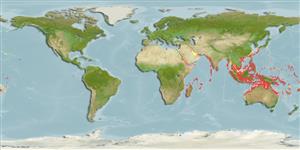>
Kurtiformes (Nurseryfishes, cardinalfishes.) >
Apogonidae (Cardinalfishes) > Apogoninae
Etymology: Taeniamia: Name from feminine Latin noun 'taenia' meaning ribbon or band; and feminine Greek noun 'Amia' meaning a fish, often used with cardinalfishes genera. Here as Taeniamia referring to the vertical wide bars and near vertical to curved narrow bars as lines on most of the species in this genus.
Issue
Apogon sansibaricus Pfeffer, 1893 is considered a valid species as Taeniamia sansibaricus in Ref. 96888, and will be separated.
Environment: milieu / climate zone / intervalo de profundidade / distribution range
Ecologia
marinhas associadas(os) a recifes; intervalo de profundidade 2 - 60 m (Ref. 9710). Tropical; 30°N - 23°S
Indo-Pacific: Persian Gulf (Ref. 68964); Red Sea and east coast of Africa, eastward to the Marshall Islands, Samoa and Tonga; north to Ryukyu Islands; south to northern Australia.
Tamanho / Peso / Idade
Maturidade: Lm ? range ? - ? cm
Max length : 10.0 cm TL macho/indeterminado; (Ref. 48635); common length : 5.9 cm SL macho/indeterminado; (Ref. 37816)
Espinhos dorsais (total) : 7; Raios dorsais moles (total) : 9; Espinhos anais: 2; Raios anais moles: 15 - 18. Diagnosis: Dorsal VII,9; Anal II,15-17 (rarely 18); Pectoral rays 14 (rarely 13 or 15). Gill rakers 4-8 + 14-18 (total 19-25). Lateral-line scales 25+3-6. Median predorsal scales 6-7 (rarely 5). Body depth 2.3-2.9 in SL; body width 2.1-2.8 in body depth; eye diameter 2.7-3.5 in head length; first dorsal spine 1.5-2.7 in second spine; second dorsal spine 2.0-2.7, and third dorsal spine 2.2-2.7 in head length; spine of second dorsal fin 2.3-2.9, and second anal spine 2.5-3.2 in head length; pelvic-fin length 4.25-5.2 and caudal-peduncle length 4.7-6.8 in SL; distance from insertion of pelvic spine to anal-fin origin 3.9-5.6 in SL. Posterior preopercular edge variable, usually with few or no serrae above angle; ventral preopercular edge serrate on posterior two-thirds. Scaly sheath along anal-fin base moderately developed (Ref. 54391).
Body shape (shape guide): short and / or deep; Cross section: compressed.
Inhabits continental and insular shelves; on coral and rocky reefs in sheltered bays and lagoon, patch reefs, with muddy, sandy and silty bottoms or coral rubble, and mangroves (Ref. 54391); typically forming dense aggregations at the entrance of caves (Ref. 1602, 48635) and among branching corals (Ref. 2334). Nocturnal species (Ref. 7300).
Life cycle and mating behavior
Maturidade | Reprodução | Desova | Ovos | Fecundidade | Larvas
Are mouthbrooders (Ref. 240). Distinct pairing during courtship and spawning (Ref. 205).
Gon, O. and J.E. Randall, 2003. Revision of the Indo-Pacific cardinalfish genus Archamia (Perciformes: Apogonidae), with description of a new species. Indo-Pac. Fish. (35):49 p. (Ref. 54391)
Categoria na Lista Vermelha da IUCN (Ref. 130435: Version 2025-1)
Ameaça para o homem
Harmless
Utilização humana
Ferramentas
Relatórios especiais
Descarregue XML
Fontes da internet
Estimates based on models
Preferred temperature (Ref.
123201): 25.1 - 29.1, mean 28 °C (based on 1030 cells).
Phylogenetic diversity index (Ref.
82804): PD
50 = 0.5001 [Uniqueness, from 0.5 = low to 2.0 = high].
Bayesian length-weight: a=0.01202 (0.00709 - 0.02039), b=3.07 (2.92 - 3.22), in cm total length, based on LWR estimates for this species & (Sub)family-body (Ref.
93245).
Nível Trófico (Ref.
69278): 3.5 ±0.50 se; based on food items.
Resiliência (Ref.
120179): Elevada, tempo mínimo de duplicação da população menor que 15 meses (Preliminary K or Fecundity.).
Fishing Vulnerability (Ref.
59153): Low vulnerability (10 of 100).
🛈
Nutrients (Ref.
124155): Calcium = 138 [69, 224] mg/100g; Iron = 0.979 [0.563, 1.703] mg/100g; Protein = 18.6 [17.4, 19.8] %; Omega3 = 0.138 [0.076, 0.244] g/100g; Selenium = 36.9 [18.6, 72.2] μg/100g; VitaminA = 56.2 [16.0, 203.9] μg/100g; Zinc = 1.7 [1.1, 2.5] mg/100g (wet weight);
